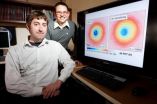(Press-News.org) CHAMPAIGN, Ill. — Coastal residents and oil-rig workers may soon have longer warning when a storm headed in their direction is becoming a hurricane, thanks to a University of Illinois study demonstrating how to use existing satellites to monitor tropical storm dynamics and predict sudden surges in strength.
"It's a really critical piece of information that's really going to help society in coastal areas, not only in the U.S., but also globally," said atmospheric sciences professor Stephen Nesbitt. Nesbitt and graduate student Daniel Harnos published their findings in the journal Geophysical Research Letters.
Meteorologists have seen large advances in forecasting technology to track the potential path of tropical storms and hurricanes, but they've had little success in predicting storm intensity. One of the biggest forecast problems facing the tropical meteorology community is determining rapid intensification, when storms suddenly transform into much stronger cyclones or hurricanes.
"Rapid intensification means a moderate-strength tropical storm, something that may affect a region but not have a severe impact, blowing up in less than 24 hours to a category 2 or 3 hurricane," Harnos said. "This big, strong storm appears that wasn't anticipated, and the effects are going to be very negative. If you don't have the evacuations in place, people can't prepare for something of the magnitude that's going to come ashore."
For example, Hurricane Charlie, which hit southern Florida in 2004, was initially forecast as a category 1 storm. However, when it made landfall less than 24 hours later, it had strengthened to a category 4, causing major damage.
Rapid intensification is so hard to predict in part because it's driven by internal processes within the storm system, rather than the better-predicted, large-scale winds that determine the direction of the storms. The satellite imagery most commonly used for meteorology only looks at the clouds at the top of the storms, giving little insight as to what's going on inside the system.
Harnos and Nesbitt focused their study on passive microwave satellite imagery. Such satellites are used commonly for estimating precipitation, surface temperature and other data. The Illinois researchers were the first to use them systematically to observe hurricane structure and intensity changes.
"What makes it ideal for what we are doing is that it's transparent to clouds. It senses the amount of ice within the clouds, which tells us the strength of convection or the overturn of the atmosphere within the hurricane," Nesbitt said. "It's somewhat like trying to diagnose somebody with a broken arm by taking a picture of the arm, versus being able to X-ray it."
The researchers scoured data from passive microwave satellites from 1987 to 2008 to see how hurricanes behaved in the 24 hours before a storm underwent rapid intensification. Such a big-picture approach, in contrast to the case studies atmospheric scientists often perform, revealed clear patterns in storm dynamics. They found that, consistently, low-shear storm systems formed a symmetrical ring of thunderstorms around the center of the system about six hours before intensification began. As the system strengthened into a hurricane, the thunderstorms deepened and the ring became even more well-defined.
The study also looked at high-shear storms, a less common phenomenon involving atmospheric winds hanging with height.
Such storms showed a different structure when intensifying: They form a large, bull's-eye thunderstorm in the center of the system, rather than a ring around the center.
"Now we have an observational tool that uses existing data that can set off a red flag for forecasters, so that when they see this convective ring feature, there's a high probability that a storm may undergo rapid intensification," Nesbitt said. "This is really the first way that we can do this in real time rather than guessing with models or statistical predictions."
Since passive microwave satellites orbit every three to six hours, meteorologists can use them to track tropical storms and watch for the telltale rings to give forecasters about a 30-hour window before a storm hits its maximum strength.
Next, the researchers hope to even further increase their forecasting ability by modeling the internal dynamics of the storm systems as they intensify to pinpoint the causes of the structural changes they observed and find out what drives the intensification process.
"The satellite gives up as snapshot of what's taking place," Harnos said. "We know what's going on, but not how those changes are occurring to end up in the pattern that we're seeing. So what we're working on now is some computer modeling of hurricanes, both real storms and idealized storms, to see dynamically, structurally, what's taking place and what changes are occurring to produce these patterns that we see in the satellite data."
INFORMATION:
The NASA Hurricane Science Research Program supported this work.
Ring around the hurricanes: Satellites can predict storm intensity
2011-04-21
ELSE PRESS RELEASES FROM THIS DATE:
Louisville, Kentucky Dentist Offering VIP Rewards
2011-04-21
People in the Louisville area can now have gorgeous smiles for less. Ideal Dentistry in Prospect, Kentucky recently began offering a unique rewards program to their customers.
"I wanted to do something to show our customers how much we appreciate them," said Dr. Christian Hahn. "Our rewards program helps people save money while encouraging them to maintain great oral hygiene."
The VIP program rewards good customers by giving them perks such as 10 percent back on services performed, lifetime warranties on porcelain and gold crowns, no-charge consultations, ...
Does video game violence harm teens? New study weighs the evidence
2011-04-21
COLUMBUS, Ohio -- How much scientific evidence is there for and against the assertion that exposure to video game violence can harm teens?
Three researchers have developed a novel method to consider that question: they analyzed the research output of experts who filed a brief in a U.S. Supreme Court case involving violent video games and teens.
Their conclusion? Experts who say violent video games are harmful to teens have published much more evidence supporting their claims than have experts on the other side of the debate.
"We took what I think is a very objective ...
Presenting cancer treatment options in small doses yields smarter choices
2011-04-21
ANN ARBOR, Mich.---Women who choose among different breast cancer treatment options make smarter choices when getting the information and making decisions in small doses rather than all at once, as is customary, a University of Michigan study found.
It's long been known that people who aren't good with numbers have a harder time understanding the risk information they need to make good medical decisions, says Brian Zikmund-Fisher, assistant professor at the U-M School of Public Health and a research assistant professor at the U-M Health System.
Zikmund-Fisher and co-authors ...
Citizens United case unlikely to end corporate speech debate
2011-04-21
CHAMPAIGN, Ill. — The debate over the constitutionality of regulating corporate speech took a significant turn in the U.S. Supreme Court's Citizens United decision, but it's an issue that almost certainly won't die down in the aftermath of that highly publicized case, says a University of Illinois business law expert.
Law professor Larry E. Ribstein says the court's 5-to-4 ruling in favor of corporate speech has sparked a furor among pundits and the public that shows little signs of ebbing.
"The debate in the aftermath of the Citizens United decision has centered on ...
GOES-13 sees an extraordinarily early Atlantic low in the tropics
2011-04-21
Hurricane season doesn't start in the Northern Atlantic Ocean until June 1, but a low pressure system in doesn't seem to want to follow the calendar. There's a low pressure area with a small chance for development north-northeast of Puerto Rico, and the GOES-13 satellite captured a visible image of the storm.
The National Hurricane Center (NHC) issued a Special Tropical Weather Outlook today, April 20, that noted the low pressure area was located about 460 miles northeast of San Juan, Puerto Rico at 3:35 p.m. EDT. The NHC noted that slow development is possible over ...
TechConnect Ohio Announces Fast-Pitch Networking Event for Ohio Companies and Motivated Jobseekers
2011-04-21
Local Ohio-based companies who rely on IT and technical talent and tech savvy jobseekers alike are invited to attend the debut of TechConnect Ohio, a company sponsored "fast-pitch" networking event that aims to connect motivated jobseekers with employers. TechConnect Ohio will include six hours of sponsor pitches, informal networking and IT workshops in a low-pressure environment, and will be held on Thursday, May 12th 2011 from 12 noon to 6pm at the OCLC Conference Center at 6565 Kilgour Place in Dublin.
"Ohio has exactly what it needs to become a world-class ...
Prenatal exposure to certain pesticides may negatively impact cognitive development in children
2011-04-21
Researchers at Mount Sinai School of Medicine have found that exposure during pregnancy to a family of pesticides called organophosphates may impair child cognitive development. The findings are published online in Environmental Health Perspectives.
From 1998 to 2002, the Mount Sinai Children's Environmental Health Study enrolled a multiethnic population of more than 400 women in their third trimester of pregnancy. The research team collected urine samples during pregnancy and analyzed them for the evidence of metabolized pesticides. The women were then invited to participate ...
Prenatal pesticide exposure tied to lower IQ in children
2011-04-21
Berkeley – In a new study suggesting pesticides may be associated with the health and development of children, researchers at the University of California, Berkeley's School of Public Health have found that prenatal exposure to organophosphate pesticides – widely used on food crops – is related to lower intelligence scores at age 7.
The researchers found that every tenfold increase in measures of organophosphates detected during a mother's pregnancy corresponded to a 5.5 point drop in overall IQ scores in the 7-year-olds. Children in the study with the highest levels ...
Use of topical corticosteroids in children with eczema does not have negative side effects
2011-04-21
A new study published in the journal Pediatric Dermatology reveals that routine, long-term use of topical corticosteroids (TCS) for treating children with eczema does not cause any significant, negative side effects.
Parental phobia of TCS is widespread and leads to poorly managed eczema in children. The commonest fear is that TCS use will "thin the skin." Parents fears are also shared by many health care providers, including pharmacists.
Led by Gayle Fischer, MBBS, FACD, of The University of Sydney, researchers studied 92 children, 70 of which were part of the study/dermatitis ...
Prenatal exposure to common insecticide linked to decreases in cognitive functioning at age 7
2011-04-21
Researchers from the Columbia Center for Children's Environmental Health at the Mailman School of Public Health report evidence of a link between prenatal exposure to the insecticide chlorpyrifos and deficits in IQ and working memory at age seven. This is the first study to evaluate the neurotoxicity of prenatal chlorpyrifos exposure on cognitive development at the time of school entry. Findings are online in Environmental Health Perspectives.
Until banned for indoor residential use by the U.S. Environmental Protection Agency in 2001, chlorpyrifos, an organophosphate ...




